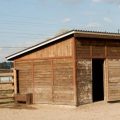Introduction to Garden Sheds in the UK
Garden sheds have long been a staple feature of residential properties across the United Kingdom. Their popularity can be attributed not only to the nation’s deep-rooted gardening culture but also to the practical needs of modern households. Whether utilised for storing tools, housing outdoor equipment, serving as hobby workshops, or providing additional workspace, garden sheds offer versatile solutions that enhance both urban and rural lifestyles.
The importance of understanding the regulatory frameworks governing garden sheds cannot be overstated. As homeowners increasingly seek to maximise their outdoor spaces, it is essential to appreciate the legal considerations that accompany such installations. Navigating planning permission requirements, complying with local authority regulations, and ensuring adherence to building standards are crucial steps in avoiding potential disputes and costly remedial actions. The following table offers an overview of common uses for garden sheds among UK households:
| Use Case | Description |
|---|---|
| Tool & Equipment Storage | Safe and organised space for gardening tools, lawnmowers, bicycles, and seasonal items. |
| Workshop or Studio | Dedicated area for DIY projects, crafts, or creative pursuits separate from the main house. |
| Home Office | A quiet workspace solution, particularly popular with remote and hybrid working trends. |
| Leisure Room | Space for relaxation or hobbies such as reading, music, or fitness activities. |
| Greenhouse Alternative | Sheltered environment for seed propagation and plant care during colder months. |
Given this diversity of uses, a clear understanding of the legal landscape surrounding garden sheds is indispensable for any UK homeowner planning a new installation or modification. This article will guide you through the key aspects of planning permission, statutory obligations, and compliance considerations specific to garden sheds in the UK.
2. Understanding Planning Permission Requirements
When considering the installation of a garden shed in the UK, it is crucial to determine whether planning permission is required. The necessity for planning permission hinges on several factors including the size, location, and intended use of the shed. Below is a detailed examination of these criteria in line with current UK regulations.
Permitted Development Rights
Most garden sheds fall under permitted development, meaning that planning permission is not typically required if specific conditions are met. However, exceeding certain thresholds may result in the need to obtain formal approval from your local planning authority.
Key Criteria Affecting Planning Permission
| Criteria | Permitted Without Planning Permission? |
|---|---|
| Total Height | Shed must not exceed 2.5 metres if within 2 metres of a boundary; otherwise, up to 4 metres for a dual-pitched roof or 3 metres for any other roof |
| Location | Shed must not be located forward of the principal elevation (the front of your house) |
| Footprint | No more than 50% of the total area of land around the “original house” (as it was first built or as it stood on 1 July 1948) can be covered by outbuildings |
| Usage | Shed must be for domestic use only (no commercial activities or separate self-contained living accommodation) |
Special Considerations for Designated Land and Listed Buildings
If your property is situated within designated land—such as conservation areas, Areas of Outstanding Natural Beauty (AONB), national parks, or World Heritage Sites—or if it is a listed building, stricter controls will apply and permitted development rights may be restricted or removed entirely.
Summary
To remain compliant with UK law, homeowners should carefully assess their proposed shed against these planning parameters. When in doubt, it is always advisable to consult with your local planning authority prior to commencing construction to avoid potential enforcement action or costly alterations later on.

3. Permitted Development Rights and Exceptions
Understanding permitted development rights is essential for homeowners in the UK considering the installation of a garden shed. Generally, most residential properties benefit from these rights, allowing for certain types of outbuildings—such as sheds—without the need to apply for formal planning permission, provided specific criteria are met. However, there are notable exceptions and restrictions that must be carefully observed to remain compliant with UK legal regulations.
Key Criteria for Permitted Development
| Criteria | Description |
|---|---|
| Maximum Height | Sheds must not exceed 2.5m in height if within 2m of a boundary, or 4m for dual-pitched roofs elsewhere. |
| Location | The shed must not be located forward of the principal elevation fronting a highway. |
| Coverage | No more than 50% of the total area of land around the original house can be covered by outbuildings. |
| Use | The building must not be used as self-contained living accommodation or have a microwave antenna. |
Exceptions: When Permitted Development Does Not Apply
- Listed Buildings: Properties on the statutory list of buildings of special architectural or historic interest require listed building consent for any works affecting their character, including garden sheds.
- Conservation Areas: In designated conservation areas, additional planning controls may restrict or remove permitted development rights, especially regarding size, placement, and visibility from public vantage points.
- Leasehold Properties: Leaseholders may need landlord or freeholder consent before erecting a shed, regardless of planning status. The lease agreement will specify any restrictions or requirements.
- Article 4 Directions: Local authorities may impose Article 4 directions removing permitted development rights in specific locations to preserve local character.
Summary Table: Permitted Development Exceptions
| Property Type/Area | Permitted Development Rights? | Addition Actions Required |
|---|---|---|
| Standard Freehold Residential Property | Yes (subject to compliance) | Follow standard PD rules above |
| Listed Building | No | Apply for listed building consent and planning permission if necessary |
| Conservation Area | Restricted/Varies | Consult local authority; possible planning application required |
| Leasehold Property | Varies (by lease terms) | Obtain written consent from freeholder/landlord; check local planning policy |
| Article 4 Direction Area | No (where applicable) | Planning application required even for minor works like sheds |
Legal Advice and Next Steps
If you are uncertain about your property’s status or whether an exception applies, it is advisable to consult your local planning authority or seek legal advice before proceeding with any construction. Ensuring compliance at an early stage can prevent enforcement action and costly remedial works later on.
4. Building Regulations and Construction Standards
When constructing a garden shed in the UK, it is crucial to consider not only planning permission but also compliance with applicable building regulations and construction standards. While most domestic outbuildings, such as sheds, are classified as ‘permitted development’ and do not typically require building regulations approval, there are specific circumstances where such rules may apply. This section discusses the key regulatory considerations for safety, materials, and proximity to boundaries.
When Do Building Regulations Apply?
Building regulations are generally aimed at ensuring safety, structural integrity, and accessibility. For standard garden sheds used solely for storage and not intended for habitation, full compliance with building regulations is not usually necessary. However, if your shed meets any of the following conditions, you may need to seek approval:
| Condition | Regulatory Requirement |
|---|---|
| The shed’s floor area exceeds 15 square metres | Must comply with building regulations |
| The shed is attached to the main dwelling | Full compliance required |
| The shed will be used as sleeping accommodation | Comprehensive building regulations apply |
| The shed’s floor area is between 15-30 square metres and located less than 1 metre from any boundary | Requires construction from substantially non-combustible materials or approval |
Key Construction Standards
Safety Considerations
Sheds must be constructed so as not to pose a risk to occupants or neighbouring properties. This includes robust foundations, secure roofing, and proper anchoring against wind loads. Electrical installations must comply with Part P of the Building Regulations.
Materials Used
While timber is the most common material for garden sheds, compliance with fire safety standards is essential—especially if your shed is close to a boundary or another structure. The use of non-combustible materials may be required in certain scenarios.
Proximity to Boundaries
If your shed is within one metre of a boundary, additional restrictions apply regarding its construction materials and fire resistance. Local authorities may have further guidelines depending on your location within the UK.
Summary Table: Compliance Checklist for Shed Construction
| Aspect | Requirement/Standard |
|---|---|
| Size up to 15m² (not attached) | No building regulations required |
| Size 15–30m² (within 1m of boundary) | Non-combustible materials needed or approval required |
| Sheds with electrical installations | Compliance with Part P necessary |
| Sheds intended for sleeping/use as accommodation | Full building regulations compliance required |
It is advisable to consult with your local authority’s Building Control Department or seek professional legal advice prior to commencing construction, ensuring that your project remains fully compliant with all relevant UK laws and standards.
5. Legal Compliance and Practical Considerations
Ensuring that your garden shed remains compliant with UK law does not end with obtaining planning permission. Ongoing legal compliance is crucial to avoid disputes, fines, or enforcement action from local authorities. Below, we explore key aspects such as maintaining good neighbour relations, respecting access rights, and considering environmental impacts—all within the context of UK regulations.
Neighbour Relations and Boundary Issues
One of the most common sources of dispute arises from sheds placed too close to boundaries or overshadowing neighbouring properties. It is considered best practice to:
- Consult with neighbours before installation.
- Ensure the shed does not encroach upon their land or block natural light unduly.
- Respect the Party Wall Act 1996 if construction is close to shared boundaries.
Access Rights and Shared Pathways
If your property shares access routes, alleys, or driveways, you must ensure that the placement of your shed does not obstruct these pathways. Infringing on rights of way can result in legal action and may require removal or relocation of the structure. The following table summarises key considerations:
| Consideration | Description |
|---|---|
| Right of Way | Ensure no part of the shed blocks designated public or private paths. |
| Maintenance Access | Avoid placing sheds where they prevent maintenance of fences or utilities. |
Environmental Impact and Sustainable Choices
The UK places increasing importance on environmental responsibility. When constructing a garden shed, consider:
- Using sustainably sourced materials (e.g., FSC-certified timber).
- Avoiding chemical treatments harmful to wildlife.
- Implementing water run-off management to prevent localised flooding.
Summary Checklist for Ongoing Compliance
| Area | Compliance Tip |
|---|---|
| Legal Documentation | Retain copies of permissions and certificates for future reference. |
| Regular Inspections | Check periodically for encroachment or changes in use that might breach regulations. |
| Neighbours’ Consent | Document any agreements made with neighbours regarding placement or access. |
By proactively addressing these practical considerations and adhering to legal obligations, you will ensure your garden shed remains a compliant and harmonious addition to your UK property.
6. Common Pitfalls and How to Avoid Them
When it comes to installing garden sheds in the UK, many homeowners inadvertently fall foul of planning permission requirements and legal regulations. Understanding these typical mistakes—and how to avoid them—can save you from costly enforcement action or forced removal of your shed. Below, we review the most frequent pitfalls and provide practical steps to ensure compliance.
Typical Mistakes Made by Homeowners
| Mistake | Description | Potential Consequence |
|---|---|---|
| Ignoring Planning Permission Rules | Assuming all sheds are permitted development without checking size, height, or location restrictions. | Retrospective planning applications, enforcement notices, or mandatory removal of the shed. |
| Overlooking Listed Building or Conservation Area Restrictions | Erecting a shed within the curtilage of a listed building or in a conservation area without additional permissions. | Legal action, fines, and requirement to restore site to original condition. |
| Building Too Close to Boundaries | Placing sheds within two metres of a boundary when over 2.5m high. | Breach of permitted development rights; neighbour disputes; enforcement notices. |
| Using Shed for Prohibited Purposes | Utilising the shed as self-contained accommodation or for commercial use without change-of-use consent. | Breach of planning control; possible prosecution or forced change of use/removal. |
Practical Steps to Prevent Legal and Regulatory Issues
- Consult Local Planning Authority (LPA): Before construction, always check with your LPA for any specific restrictions affecting your property, especially if you live in a conservation area or own a listed building.
- Review Permitted Development Rights: Familiarise yourself with national guidelines on outbuildings, including size, height, and placement limits. The Planning Portal is an excellent resource for up-to-date information.
- Consider Your Neighbours: Engage with neighbours early if your proposed shed is near boundaries to prevent disputes and potential complaints that could lead to enforcement action.
- Maintain Proper Documentation: Keep records of correspondence with authorities and any permissions granted. This can be invaluable if any questions arise in the future regarding compliance.
Avoiding Common Pitfalls: Summary Table
| Pitfall | Avoidance Tip |
|---|---|
| Incorrect Size/Height Placement | Measure carefully against permitted standards before ordering materials or constructing the shed. |
| No Prior Checks with LPA | Contact your council’s planning department prior to any works, even if you believe your project is straightforward. |
| Poor Record Keeping | Create a file for all related documents—plans, approvals, correspondence—for future reference. |
Final Thoughts
The key to successful garden shed installation is diligence at every stage—from initial research to final completion. By proactively addressing potential regulatory issues, you protect your investment and enjoy peace of mind knowing your garden structure is fully compliant with UK law and local policies.
7. Conclusion and Resources for Further Guidance
In summary, installing a garden shed in the UK requires careful consideration of planning permission requirements, compliance with local council regulations, and adherence to national legal standards. Homeowners should ensure their sheds meet the permitted development criteria, respect boundary distances, and conform to height and usage restrictions. Failing to comply can result in enforcement action or removal orders by local authorities.
Summary of Key Points
| Key Area | Summary |
|---|---|
| Planning Permission | Generally not required if within size/height limits and not used as living accommodation. Check local council rules for exceptions. |
| Building Regulations | Sheds under 15m² typically exempt unless used for sleeping. Fire safety and structural integrity must still be considered. |
| Boundary Rules | Sheds should not exceed 2.5m in height if within 2 metres of a boundary; otherwise, up to 4m if detached and further away. |
| Listed Buildings/Conservation Areas | Stricter controls apply; always consult your local planning authority before installation. |
Trusted UK Resources for Advice
- Planning Portal: Official government guidance on permitted development rights for outbuildings.
- Your Local Council: Contact the planning department directly for site-specific advice or applications.
- CAB (Citizens Advice Bureau): Independent advice on housing improvements and legal rights.
- Historic England: For guidance relating to listed properties or conservation areas – see their outbuildings section.
Next Steps for Homeowners
If you are unsure about any aspect of shed installation or your specific circumstances, it is strongly recommended to consult your local planning authority or seek professional legal advice. Staying informed about current regulations helps ensure your garden shed project remains compliant and avoids costly pitfalls.


